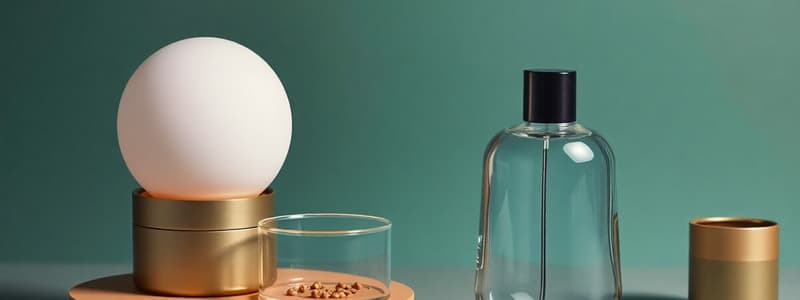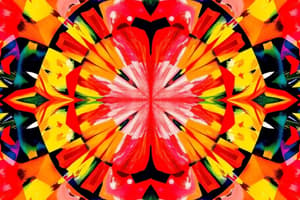Podcast
Questions and Answers
What is a primary characteristic of materials used in rapid prototyping?
What is a primary characteristic of materials used in rapid prototyping?
- They are often rigid and inflexible.
- They are typically lightweight and easy to manipulate. (correct)
- They must have high thermal conductivity.
- They must possess biocompatibility for medical applications.
Which type of prototype is primarily used for exploring design concepts and testing functionality?
Which type of prototype is primarily used for exploring design concepts and testing functionality?
- Visual prototype
- Functional prototype (correct)
- Engineering prototype
- Presentation prototype
How does ergonomics influence the design of prototypes?
How does ergonomics influence the design of prototypes?
- By ensuring prototypes are aesthetically pleasing.
- By focusing solely on the materials used in the prototype.
- By optimizing user interaction and comfort. (correct)
- By standardizing dimensions across all prototypes.
What is a common technique used in 3D modeling for rapid prototyping?
What is a common technique used in 3D modeling for rapid prototyping?
Which statement accurately describes the rapid prototyping process?
Which statement accurately describes the rapid prototyping process?
Flashcards
Rapid Prototyping
Rapid Prototyping
A method of quickly creating accurate 3D models, using computer-controlled machines that build them layer by layer.
Solid Models
Solid Models
Detailed 3D representations of objects.
Computer-controlled machinery
Computer-controlled machinery
Machines guided by computer instructions to build objects layer by layer.
Layer-by-layer
Layer-by-layer
Signup and view all the flashcards
Study Notes
Aesthetics in Product Design
- Aesthetics is concerned with how something looks and how it appeals to the human eye.
- In product design, aesthetics is very important, as the human eye is first attracted to initial looks before investigating other factors, such as function.
Important Aesthetic Factors in Product Design
- Does the product appeal to its target market?
- Does it blend in with its surroundings?
- Does the product look robust, durable, and sturdy?
- Does it look clean and easy to keep clean?
- Does the product look expensive?
- Does the product look better than similar products already available?
- Studies show humans prefer symmetrical things over asymmetrical ones.
Idea Generation Techniques
- Designers use various techniques to generate large amounts of ideas quickly.
- Brainstorming/Thought Showers: A group activity where people from diverse backgrounds discuss new ideas.
- Technology Transfer: Adapting solutions from other areas of technology or nature to generate new ideas.
Lateral Thinking
- Lateral thinking is about "thinking outside the box."
- It involves avoiding obvious solutions to overcome traditional problems and come up with innovative ideas.
- Analogies are a way to generate ideas by comparing a product or problem with something else.
Intellectual Property Rights (IPR)
- Confidentiality: Covers recipes, formulas, and information related to products.
- Copyright: Covers creative works like music, songs, stories, and films.
- Patent: Covers technology, gadgets, mechanisms, and new products. Must be applied for to the Patent office.
- Trademark: Covers technology, gadgets, mechanisms, and new products. Must be applied for to the Patent Office.
- Brand: Covers a company's image, quality, reliability, and status (symbols).
- Design Rights: Covers new versions of an existing product that looks or functions differently.
- Registered Design: Covers the appearance or style of a product.
Modeling Techniques in Product Design
- Designers use different modeling techniques to generate ideas, develop designs, and communicate information.
- Various model types (e.g., mock-ups, test models/rigs, scale models, block models, rapid prototypes) are used at different stages of the process, employing varied materials.
Graphic Tech - Mock-Ups
- Quick models to help generate ideas or check aesthetics.
- Can be drawn on paper to check sizes and ergonomics.
- Used early in the design process to generate ideas and check early concepts.
Test Model/ Test Rig
- Working models of parts or sections to check if mechanisms and electronics work correctly.
- Used during development to check internal components and sizes for later parts.
- Used to see if parts will work correctly and if a product will wear or break easily.
Scale Model
- Smaller or larger versions of the product to show clients and consumers.
- Helpful for showing what the design will look like.
- Used to get feedback from stakeholders to adjust the design before full-scale manufacturing.
- Used for advertising purposes.
Prototypes
- Full-size working models that look and function like the final product.
- Very expensive to produce.
- Used to check for functionality, ergonomics, and other final product traits.
3D Computer Models
- Computer-generated 3D models to detail designs, aid in manufacture, and check safety and performance.
- Rapid prototyping uses these for highly accurate and quickly produced parts.
Rapid Prototyping
- Process of quickly generating accurate models using layers of material.
- Additive process, starting with nothing and building the product by adding layers.
- Used to check ergonomics, assembly, function, etc, of products.
- Differentiate from CNC machining (reductive process that starts with a material and removes to make the defined product).
The Process of Rapid Prototyping
- Begins with a 3D model created in a computer modeling program.
- The 3D model is converted into a file containing thousands of thin layers that form the original 3D model.
- The file is sent to a rapid prototyping machine. This machine builds the product layer by layer.
- Overhanging areas are supported by a water-soluble material that is eliminated after the process.
- Wide variety of materials used in building these models.
Advantages of Rapid Prototyping
- Quick model production compared to manual models.
- Accurate models to within 1/1000th of a millimeter.
- Check that all parts fit together to avoid costly mistakes after production.
- Evaluate ergonomics on the model.
- Reduces product development time. Quickly identify and edit mistakes on the computer model.
- Allows design of complex shapes.
Disadvantages of Rapid Prototyping
- Expensive equipment.
- Limited to the material of the machine used to build the prototype, this might not be the material desired.
- Limited by the "envelope size" of the machine used to create the prototype - thus is not the best way for large scale products.
The Design Team
- Professionals with diverse skills contributing to design and manufacture.
- Design, manufacture, marketing teams, accountant, lawyer amongst others involved.
Designer Role in the Design Team
- Designs and develops products for function and appeal to the target market.
- Communicates design and manufacturing information amongst team members.
Engineer Role in the Design Team
- Ensures electronic and mechanical components are reliable, working, and durable.
- Chooses appropriate materials to ensure reliability.
- Communicates with designers during manufacture about aspects like product component size.
Manufacturer Role in the Design Team
- Responsible for manufacturing the product according to specifications.
- Ensures products are manufactured and assembled easily.
Market Researcher Role in the Design Team
- Researches and communicates market and consumer information to the designer.
- Sorts out necessary materials and gets them for manufacture.
- Responsible for advertising and sales.
Accountant Role in the Design Team
- Runs feasibility studies to ensure profit-making.
- Manages financial aspects. Funds outlay
Lawyer Role in the Design Team
- Manages legal aspects of design, including patents, licensing and product safety.
Studying That Suits You
Use AI to generate personalized quizzes and flashcards to suit your learning preferences.




